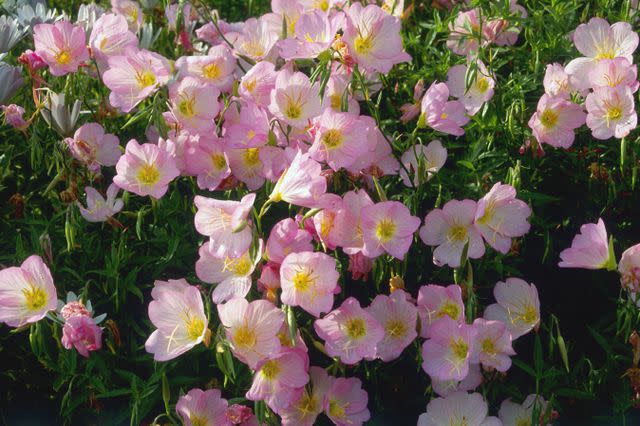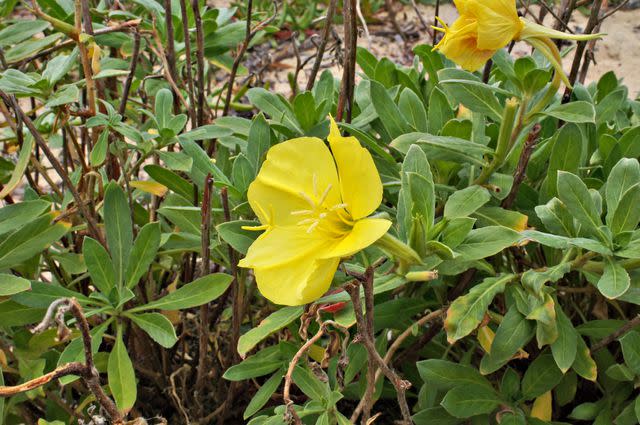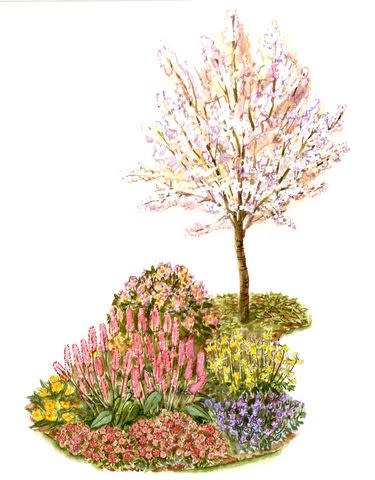How to Plant and Grow Evening Primrose
Evening pollinators will flock to the fragrant blooms of this almost-too-easy-to-grow herbaceous night-bloomer.
Evening primrose (genus Oenothera) features cupped flowers in sunny yellows, moony whites, and soft pinks. It comes from a family of flowering plants—many native to North America—that behave as perennials, biennials, or annuals depending on the variety and climate.
The most well-known of the bunch, Common evening primrose (Oenothera biennis), grows as an herbaceous biennial in fields, thickets, glades, and prairies across most hardiness zones (3-9), but there are other varieties that grow abundantly across the country like Northern evening primrose (Oenothera parviflora) and Showy evening primrose (Oenothera speciosa). Some varieties of evening primrose feature a heady citrus scent with a touch of spice while other blooms are more reminiscent of lavender or lily of the valley.
A favorite among pollinators, evening primrose blossoms produce a compound called linalool, a spicy, citrusy terpene (similar to bergamot) that draws in bees, butterflies, and hummingbirds whenever the blooms are open. However, evening primrose earned its common name because its fragrant flowers open at dusk and typically remain open only until the sun returns the next morning. This habit allows nighttime pollinators like sphinx moths, hawkmoths, and bats to play a major role in pollination and plant production.
Where to Plant Evening Primrose
Evening primroses are part of the Oenothera genus, a classification of herbaceous flowering plants that contains approximately 145 species of plants native to the Americas and 80 plants native specifically to North America. Placement requirements will vary among the varieties, but most evening primroses prefer full sun and soil with excellent drainage.
Evening primroses bloom happily in prairie and wildflower gardens and can be used to add color along wild pathways and roadsides. They can even grow in rocky, barren soil where other plants would perish. Evening primroses make an excellent addition to moon gardens (where they can bloom
alongside other night bloomers like four o’clocks, angel’s trumpets, and moonflowers), but use caution when planting them in fertile soil as they can get weedy.
Invasive Plant
While evening primrose is not banned in any U.S. state, it is considered weedy and aggressive in many areas. Some varieties, like Mexican evening primrose or showy evening primrose, can self-seed and spread aggressively—especially in fertile, hospitable environments. If not properly managed, these plants can escape their initial planting and displace other plants or completely overtake a garden bed.
How and When to Plant Evening Primrose
Despite its weediness in some regions, you can buy both young evening primrose plants and seeds at garden centers and nurseries across the country. Young evening primrose plants can be put in the ground whenever they arrive in nurseries, but they may not flower for a full year after being planted.
To grow evening primrose from seed, plan to start in the spring about 8 to 10 weeks before the last frost. Before you plant your seeds, place them in a plastic bag filled with moist sand and cold-stratify them for at least 60 days in the refrigerator. When the time arrives, sow your seeds by placing them about 4 to 6 inches below the soil line in groups of three or four and water them thoroughly. The spacing requirements will differ by variety but should be based on the mature width of the plant. If you don’t know the eventual width of your variety, place your plantings about 12 inches apart.
In the fall, you can direct-sow fresh seeds in the ground. After they are planted, keep the soil consistently moist, but not wet, just until freezing temperatures arrive.
Evening primroses can also be grown in containers, but not all varieties are suited for it—especially those with exceptionally long root systems. Be sure to choose a very deep pot that is at least two inches wider than the root system.
Evening Primrose Care Tips
With brilliant (often fragrant) yellow, pink, or white goblet-shape blooms, evening primroses are so easy to grow you'll find them thriving uncared for along roadsides. Take note, though: Some varieties of this herbaceous plant spread enthusiastically and need control.
Light
Despite their nighttime blooming habits, evening primrose plants do best when planted in full sun and get at least 6 hours of exposure daily. Some varieties will tolerate dappled sunlight and partial shade (especially in areas with very hot summers) but all are likely to develop rot or die if planted in full shade.
Soil and Water
Evening primrose plants prefer loamy, sandy soil with a neutral to slightly acidic pH (5.5 to 7.0). They are highly drought-tolerant and are happiest in open, sunny meadows or when grown in rocky soil with only a little moisture.
Unless your region suffers from significant dry spells, your evening primrose plants should require little (if any) supplemental water. If you are watering yours, watch for browning and discoloration of the leaves as this may be a sign of overwatering.
Temperature and Humidity
Evening primrose is a sun-loving plant that prefers temperatures between 64- and 72 degrees Fahrenheit. It will suffer frost damage in temperatures below 15 degrees, but that damage is unlikely to deter the plant from returning in the spring. If you experience prolonged temperatures above 80 degrees Fahrenheit and don’t have trees or structures to protect your evening primrose plants from the harshest afternoon sun, they may also suffer damage.
Evening primroses prefer a dry to only moderately humid environment. Prolonged high humidity may cause your plants to develop fungal infections and rot.
Fertilizer
Evening primrose can grow even in poor, rocky soil, so most varieties will not require fertilization—especially in their native climates. If you want to encourage more prolific flowering, apply a liquid fertilizer that is high in phosphorus, following product label instructions, or amend your soil with organic material before planting.
Pruning
It is not necessary to prune your evening primroses to maintain basic plant health, but you can cut them back after blooming if you wish to prevent self-seeding. Just pinch or snip off the fading flowers before they go to seed and discard the blooms in a trash bag. Do not toss them on the ground or in a compost bin.
Pests and Problems
Aphids, leafhoppers, and spider mites are common pests for evening primrose plants. If you spot them, spray them off with soapy water. Slugs and snails are also common visitors to evening primrose plants, but they can be deterred with traps, bait, or abrasives like eggshells, dry ash, or diatomaceous earth. You may occasionally spot beetles dining on the leaves of your evening primrose plant, but they are unlikely to cause significant damage.
If your evening primrose plants are placed in an area with poor drainage, they may be susceptible to root rot, crown rot, and fungal infections. If any of these develop, your plants might still be salvageable. Before tossing them, amend your soil with compost or relocate the plants to an area with better drainage.
How to Propagate Evening Primrose
The easiest way to propagate evening primrose is via seed—and if you already have plants, you don’t need to buy seeds. You can harvest them straight from your existing plants when the seed pods turn brown and papery. Just be sure to capture them before the seed pods open and spill the seeds to the ground. Freshly harvested seeds can be planted immediately in the fall or you can save them until spring and cold-stratify them before sowing them in the ground.
Some evening primrose plants can also be divided. Oenothera macrocarpa (or big fruit evening primrose), doesn’t take well to it, but others may benefit from an occasional division. To do so, carefully dig up a root system and slice the roots apart into equal sections with a sharp, sterile blade. Plant each new section at least 6 to 12 inches apart.
Types of Evening Primrose
'Greencourt Lemon' Missouri Sundrops

Oenothera macrocarpa 'Greencourt Lemon' has pale greenish-yellow goblet flowers on red stems. Each flower may reach 5 inches across, and the plants grow 6 inches tall. Native to the southern and central parts of the United States, it is hardy in zones 3-7 and can be found growing in dry forest clearings, along roadsides, and on well-draining rocky bluffs.
'Lemon Drop' Primrose

Oenothera 'Lemon Drop' is an ultra-tough selection that holds up very well to heat and drought. Unlike other evening primroses, Lemon Drop flowers stay open during the day. This variety blooms in spring and summer and tends to grow 12 inches tall and 24 inches wide. You can plant it in zones 5-11.
Showy Evening Primrose

Showy evening primrose (a.k.a., pink ladies, Mexican evening primrose, or Oenothera speciosa) is native to the southwestern parts of the United States and Mexico. It makes an excellent heat-, drought- and humidity-tolerant groundcover that rewards you in midsummer with cupped pink flowers that open in the evening or on cloudy days. It's pretty and easy to grow, but showy evening primrose is a bit of a garden bed bully. It spreads aggressively in ideal conditions, so make sure it has room to ramble or be ready to tackle lots of volunteer plants. You can also plant it in rocky, infertile soil to slow its growth. Showy evening primrose is hardy in zones 5-8.
Mexican Evening Primrose

Oenothera speciosa var. childsii is less aggressive than standard showy evening primrose and bears delicate 1-inch pink flowers veined in deeper pink. The 12-inch-tall plants bear softly hairy lance-shaped leaves on slender stems. It is hardy in zones 5-8.
Rosy Evening Primrose

Pink evening primrose (Oenothera rosea) is native to northern Mexico and Texas. It features masses of fragrant, saucer-shape blooms that typically measure 2 inches across and have a bright yellow center. Flowers tend to appear from late spring to midsummer and are followed by seed capsules that are easily captured by the wind. It is hardy in zones 4-9 and can be aggressive if not managed or contained.
Beach Evening Primrose

Beach evening primrose (Oenothera drummondii), as the name implies, is typically found on sandy beaches. It features sunny yellow petals, sometimes tipped in pale yellow or white. It has a creeping, sometimes shrubby growth habit. Beach evening primrose is native to northern Mexico and the southeastern United States, so it grows best in temperate, Mediterranean-like climates, deserts, and subtropical regions. It is hardy as a perennial in zones 8-11 but can be grown as an annual in zones 3-8.
Evening Primrose Companion Plants
Loosestrife Lysimachia

Loosestrifes are vigorous growers and beautiful additions to almost any garden (in zones 4-9). They vary from tall, stately plants suitable for borders to others that can be planted as creeping groundcovers. The blooms vary too—from tight spikes of 1/2 inch to 1-inch cups carried alone or in whorls. Humus-rich, moisture-retentive soil is recommended (though some varieties enjoy wet soil and ample water). Several sorts may become aggressive and need to be corralled. It should be noted that these are not the invasive purple loosestrife, which has been banned in many parts of the United States.
Helenium

Part of a big group of native plants in the daisy family, helenium offers cheery yellow, orange, or red blooms at the end of the season. And despite its common name of sneezeweed, it won't aggravate your allergies. It is so named because the flowers were made into snuff in the past, used to induce sneezing to clear out congestion. Zones 3-8
Daylily

Daylilies are so easy to grow you'll often find them thriving in ditches and fields. These rogue flowers are likely escapees from gardens, but they look so delicate with their glorious trumpet-shaped blooms—some fragrant—in tropical colors. There are some 50,000 named hybrid cultivars with a range of bloom sizes (the minis are very popular), as well as different forms and plant heights. Although each bloom lasts but a single day, superior cultivars carry numerous buds on each scape so bloom time is long, especially if you deadhead daily. The strappy foliage of daylilies may be evergreen or deciduous. Zones 3-10
Garden Plan for Evening Primrose
Island Flower Bed

Break up the monotony of a boring stretch of landscape with a garden plan that is as stunning from the back as it is from the front and side. This low-maintenance space is anchored by an ornamental plum tree and features a collection of perennials (like bellflowers and golden columbine) and flowering groundcovers (like barrenwort) to add seasonal splashes of color. You can add even more color with a series of optional spring bulbs like daffodils and tulips.
Frequently Asked Questions
Are evening primrose plants related to primroses?
Despite their common name, evening primrose is not a close cousin to true primroses (Primula). Evening primroses are part of the Oenothera genus, a collection of flowering herbaceous plants mostly native to North America. Primula primroses are early-blooming perennials that come in a rainbow of colors and are hardy in zones 2-8. Most primroses feature clusters of dainty blossoms held at the end of long stalks.
How long do evening primrose plants live?
The lifespan of evening primroses depends on the variety and climate, but most are biennials that live approximately two years. They are, however, self-seeding and will continue to grow year after year in the same spot (and often beyond) once planted.
For more Better Homes & Gardens news, make sure to sign up for our newsletter!
Read the original article on Better Homes & Gardens.

